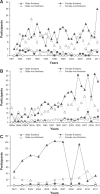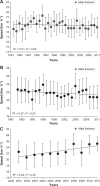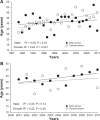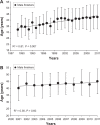Participation and performance trends in ultracycling
- PMID: 24379708
- PMCID: PMC3871902
- DOI: 10.2147/OAJSM.S40142
Participation and performance trends in ultracycling
Abstract
Background: Participation and performance trends have been investigated in ultramarathons and ultratriathlons but not in ultracycling. The aim of the present study was to investigate (1) participation and performance trends in ultraendurance cyclists, (2) changes in cycling speed over the years, and (3) the age of the fastest male and female ultraendurance cyclists.
Methods: Participation and performance trends in the 5000 km Race Across America (RAAM) and in two RAAM-qualifier races - the 818 km Furnace Creek 508 in the United States and the 715 km Swiss Cycling Marathon in Europe - were investigated using linear regression analyses and analyses of variance.
Results: On average, ~41% of participants did not finish either the RAAM or the Furnace Creek 508, whereas ~26% did not finish the Swiss Cycling Marathon. Female finishers accounted for ~11% in both the RAAM and the Furnace Creek 508 but only ~3% in the Swiss Cycling Marathon. The mean cycling speed of all finishers remained unchanged during the studied periods. The winner's average speed was faster for men than for women in the RAAM (22.6 ± 1.1 km · h(-1) versus 18.4 ± 1.7 km · h(-1), respectively; average speed difference between male and female winners, 25.0% ± 11.9%), the Swiss Cycling Marathon (30.8 ± 0.8 km · h(-1) versus 24.4 ± 1.9 km · h(-1), respectively; average speed difference between male and female winners, 27.8% ± 9.4%), and the Furnace Creek 508 (27.4 ± 1.6 km · h(-1) versus 23.4 ± 3.0 km · h(-1), respectively; average speed difference between male and female winners, 18.4% ± 13.9%). In both the Furnace Creek 508 and the Swiss Cycling Marathon, ~46% of the finishers were aged between 35 and 49 years. The mean age of winners, both male and female, across the years in the Furnace Creek 508 and in the Swiss Cycling Marathon was 37 ± 10 years.
Conclusion: These findings in ultracycling races showed that (1) ~26%-40% of starters were unable to finish, (2) the percentage of female finishers was ~3%-11%, (3) the gender difference in performance was ~18%-28%, and (4) ~46% of the successful finishers were master athletes. Future studies need to investigate the reasons for the low female participation and focus on the age-related performance decline in other ultraendurance events in order to confirm that master athletes are predisposed to ultraendurance performances.
Keywords: cycling; finisher; gender difference; master athlete; speed; ultraendurance.
Figures






Similar articles
-
Age and gender difference in non-drafting ultra-endurance cycling performance - the 'Swiss Cycling Marathon'.Extrem Physiol Med. 2013 Jun 4;2(1):18. doi: 10.1186/2046-7648-2-18. Extrem Physiol Med. 2013. PMID: 23849106 Free PMC article.
-
Men cross America faster than women--the "Race Across America" from 1982 to 2012.Int J Sports Physiol Perform. 2013 Nov;8(6):611-7. doi: 10.1123/ijspp.8.6.611. Epub 2013 Feb 20. Int J Sports Physiol Perform. 2013. PMID: 23434612
-
Finishers and nonfinishers in the 'Swiss Cycling Marathon ' to qualify for the 'Race Across America '.J Strength Cond Res. 2011 Dec;25(12):3257-63. doi: 10.1519/JSC.0b013e31821606b3. J Strength Cond Res. 2011. PMID: 22080313
-
Ultra-Cycling- Past, Present, Future: A Narrative Review.Sports Med Open. 2024 Apr 29;10(1):48. doi: 10.1186/s40798-024-00715-7. Sports Med Open. 2024. PMID: 38679655 Free PMC article. Review.
-
Physiology and Pathophysiology in Ultra-Marathon Running.Front Physiol. 2018 Jun 1;9:634. doi: 10.3389/fphys.2018.00634. eCollection 2018. Front Physiol. 2018. PMID: 29910741 Free PMC article. Review.
Cited by
-
Trends in Triathlon Performance: Effects of Sex and Age.Sports Med. 2013 Sep;43(9):851-63. doi: 10.1007/s40279-013-0067-4. Sports Med. 2013. PMID: 23797729 Review.
-
Variability and the form-function framework in evolutionary biomechanics and human locomotion.Evol Hum Sci. 2022 Jul 7;4:e29. doi: 10.1017/ehs.2022.28. eCollection 2022. Evol Hum Sci. 2022. PMID: 37588899 Free PMC article. Review.
-
Older or Wiser? Age and Experience Trends in 20 Years of Olympic and World Swimming Championships Open Water 10-km Races.J Funct Morphol Kinesiol. 2021 Oct 29;6(4):89. doi: 10.3390/jfmk6040089. J Funct Morphol Kinesiol. 2021. PMID: 34842749 Free PMC article.
-
Swimming performances in long distance open-water events with and without wetsuit.BMC Sports Sci Med Rehabil. 2014 May 21;6:20. doi: 10.1186/2052-1847-6-20. eCollection 2014. BMC Sports Sci Med Rehabil. 2014. PMID: 24891942 Free PMC article.
-
Sex and age-related differences in performance in a 24-hour ultra-cycling draft-legal event - a cross-sectional data analysis.BMC Sports Sci Med Rehabil. 2014 May 15;6:19. doi: 10.1186/2052-1847-6-19. eCollection 2014. BMC Sports Sci Med Rehabil. 2014. PMID: 24883191 Free PMC article.
References
-
- Hoffman MD. Performance trends in 161-km ultramarathons. Int J Sports Med. 2010;31(1):31–37. - PubMed
-
- Hoffman MD, Ong JC, Wang G. Historical analysis of participation in 161 km ultramarathons in North America. Int J Hist Sport. 2010;27(11):1877–1891. - PubMed
-
- Knechtle B, Knechtle P, Lepers R. Participation and performance trends in ultra-triathlons from 1985 to 2009. Scand J Med Sci Sports. 2011;21(6):E82–E90. - PubMed
LinkOut - more resources
Full Text Sources
Other Literature Sources

